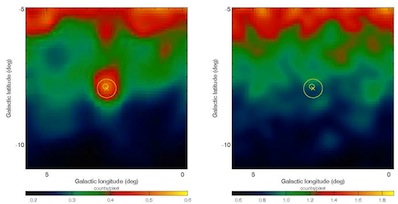
Record breaking pulsar spins a web of mysteries
by Amanda Doyle
for ASTRONOMY NOW
Posted: 04 November 2011


The youngest and most distant gamma ray millisecond pulsar, which was observed by the Fermi Gamma-ray Space Telescope, isn't behaving quite as it should.
The pulsar, named J1823-3021A, is situated towards the centre of the Galaxy in the globular cluster NGC 6624. Discovered in 1990, it is the most luminous radio pulsar ever detected in a globular cluster and it comes with an additional surprise: it is equally dazzling in gamma rays.

Fermi LAT gamma-ray image of the the globular cluster NGC 6624. Left: Pulsar J1823-3021A is ON; Right: Pulsar is OFF. None of the other five known pulsars in this cluster are detectable in gamma rays because of its huge distance. Image: P Freire et al., Science Express.
NGC 6624 is at a distance of around 27,000 light years from us making J1823-3021A the most distant millisecond pulsar every detected via gamma rays. The globular cluster was originally thought to harbour around 100 millisecond pulsars, which was deduced from the overall gamma ray glow. Most pulsars can't be resolved at this distance and J1823-3021A is one of only six which have been individually detected in this cluster. Once Fermi observations showed how bright J1823-3021A is in gamma rays, astronomers realised that in fact only around 30 millisecond pulsars exist in this globular cluster. This is because gamma ray radiation emanating from the globular cluster is comprised of light mainly from this one particular pulsar.
A pulsar is an extremely dense, dead star which typically emits radio beams that sweep past the Earth like a lighthouse. The spinning magnetic field of a pulsar induces a high voltage and this can accelerate particles to high enough energies for them to emit gamma rays.

Globular cluster NGC 6624 in the constellation Sagittarius, where six individual pulsars have been detected. Image: NASA/ESA/I. King (Univ. of California, Berkeley).
Millisecond pulsars are pulsars which rotate much faster than ordinary pulsars after accreting material from a companion in a binary. J1823-3021A only takes 5.44 milliseconds to rotate, meaning it spins around 11,000 times every minute. The process which gives millisecond pulsars their high rotation speed also reduces their magnetic field – at least it should. J1823-3021A has thrown a spanner in the works as its magnetic field has not diminished as much as expected. This unusual observation has yet to be explained.
The pulsar is thought to be around 25 million years old, making it one of the youngest millisecond pulsars known. This was determined because the rate of change of the period, known as the spin-down rate, is unusually high. “Up to now, we have assumed that the observed spin-down rate was an artefact and not real but caused by an extrinsic effect due to a movement of the pulsar in the cluster,” Michael Kramer from the Max-Planck-Institut für Radioastronomie tells Astronomy Now. “However, the luminosity seen at gamma rays can now be compared to what's theoretically possible as computed from the spin-down rate. We conclude that the observed spin-down rate is actually the real one which then has an implication for the age as young pulsars spin-down faster.”
Kramer is confident that more pulsars such as this one will be found. “We seem to have found the 'easy ones' so far, i.e. the bright and obvious ones. Digging deeper means deeper observations and more computing power which will be available. Fermi has turned out to be a wonderful discovery machine for pulsars, and we can expect that this will continue. Lots of fun ahead!”
|



